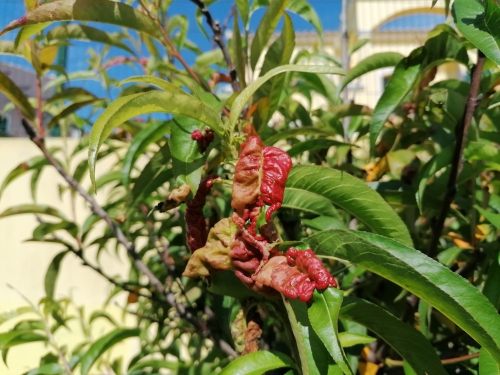by Piter Kehoma Boll
Fungi are essential for the maintenance of life on Earth, but some of them are also a pain in the leaf, such as Taphrina deformans, which causes the disease known as peach leaf curl.
As you can imagine, peach leaf curl is a disease that affects peach trees (as well as nectarines, which are nothing but a variety of peach) and eventually can occur on almond trees too. The hyphae grow between the leaf cells and secrete enzymes that degrade cellulose, as well as indole-3-acetic acid, a type of auxin, i.e., a plant hormone that induces cell growth and division. As a result, infected leaves start to curl inward and downward and turn from green to pale yellow and eventually red.

When the peach leaf-curl fungus is mature, it produces vertical hyphae that grow toward the surface of the leaf, spread just below the cuticle, and form asci, sac-like cells filled by ascospores, the sexual spores. The asci break through the leaf’s surface and cause a whitish aspect. The ascospores produce conidia, the asexual spores, and those are released in the environment, where they wait for the ideal conditions to germinate.
Conidia often remain attached to the branches of the tree and grow in a yeast-like fashion. They infect new leaves as soon as they start to grow. In order to germinate and infect leaves, conidia require about 3 mm of rainfall followed by 12 days with enough humidity and temperatures below 19 °C. As a result, infections are much more common in temperate regions and do not occur every year, as sometimes the requirements are not met. Fungicide is often efficient to stop the infections, but if humidity is too high and the fungus has spread too much, the treatment may not be efficient enough.
Infected leaves fail to make photosynthesis effectively and die earlier. As a result, the plant becomes weak and produces few or no fruits, which may cause total yield loss.
The genome of the peach leaf-curl fungus has been sequenced and showed to be considerably small compared to other fungal pathogens. Nevertheless, about 5% of its genes are only found in other fungal pathogens, including, for example, enzymes that are able to break the cuticle of plants, which is necessary for infection to occur.
Genes capable of producing plant hormones, such as the auxin mentioned above, appear to be absent in closely related species. Although the idea that they may have been acquired from the plants themselves via horizontal gene transfer has been raised, a deeper analysis suggest that they are formed by very different pathways and probably evolved independently.
When something works, nature invents it more than once, although sometimes the second invention serves as a way to cheat the first one.
– – –
– – –
References:
Cissé OH, Almeida JMGCF, Fonseca A, Kumar AA, Salojärvi J, Overmyer K, Hauser PM, Pagni M (2013) Genome Sequencing of the Plant Pathogen Taphrina deformans, the Causal Agent of Peach Leaf Curl. mBio 4(3):e00055-13. https://doi.org/10.1128/mBio.00055-13
Martin EM (1940) The morphology and cytology of Taphrina deformans. American Journal of Botany 27(9):743–751. https://doi.org/10.2307/2436901
Wikipedia. Taphrina deformans. Available at <https://en.wikipedia.org/wiki/Taphrina_deformans>. Access on 25 June 2020.
– – –
* This work is licensed under a Creative Commons Attribution 4.0 International License.
This work is licensed under a Creative Commons Attribution 4.0 International License.
** This work is licensed under a Creative Commons Attribution-ShareAlike 4.0 International License.
This work is licensed under a Creative Commons Attribution-ShareAlike 4.0 International License.

